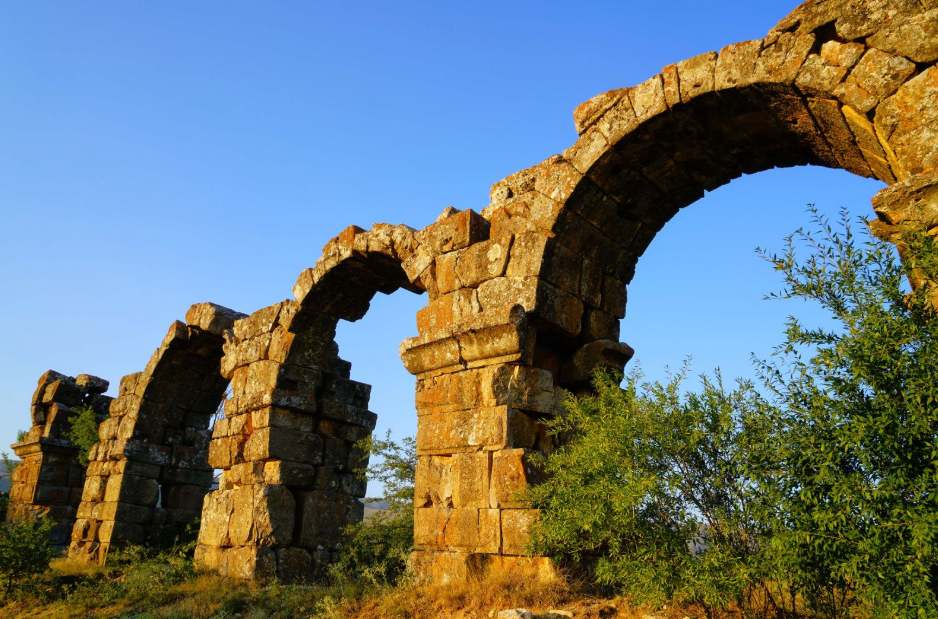The ancient city of Pisidia Antioch is located approximately 1 kilometer northeast of Yalvaç district of Isparta province in the Lakes Region, which is the intersection of the Mediterranean, Aegean, and Central Anatolia regions. The city was built on a sloping and partly rocky terrain. Hisarardı road passes through the northern and western borders of the city, and Antiochos (Hisarardı) Stream passes through the southeastern border. The city has a trapezoidal plan, and there are remains of buildings from the Roman and Byzantine Periods. While the main entrance gate of the city is located in the west, there are remains of structures such as Aqueducts, a Nympheum, and Baths in the north. In the center are the Theater, the Tiberius Area, the Propylon, and the Temple of Augustus.

Pisidia Antiokheia Ancient City (Türkiye Culture Portal)
Historical Development and Importance
The ancient city of Antioch is located on a hill reaching 1236 meters in the Yalvaç district of Isparta. It is estimated that the population of the city, whose 46-hectare acropolis is surrounded by walls, was around 70,000 during the Roman Period. Founded by the Seleucid dynasty in the 3rd century BC, the city bears the characteristics of the Hellenistic period. It is known that the region has been inhabited since the Paleolithic period and that there were Early Bronze Age settlements dating back to 3000 BC. It is thought that Antioch was founded in 275 BC as a strategic outpost to control Galatian raids. The region, which came under Roman rule from the 2nd century BC, came under the control of the Seljuks after the Battle of Miryokefalon in 1176.
The ancient city is an important pilgrimage center for Christianity. The Great Basilica of Antioch, which hosted the Archbishopric of Pisidia, stands out as the earliest and monumental Christian structure of the region.
Architectural Structures and Urban Planning
The city planning of the Ancient City of Pisidia Antioch has a trapezoidal shape and contains the remains of buildings from the Roman and Byzantine Periods. The main entrance of the city is located in the west direction. Remains of structures such as Aqueducts, Nymphaeum, and Baths can be seen in the north. In the center of the city are the Theater, the Tiberius Area, the Propylon, and the Temple of Augustus. The aqueducts are partially standing in the northeast direction.
Among the structures uncovered by the excavations are the Bath-Basilica structure, the Theater, the Nymphaeum (fountain structure), the western gate and its surroundings, the Decumanus Maximanus (main street in the east-west direction) and Cardo Maximanus (main street in the north-south direction) streets, and the street entrances on both sides of these streets. The Church of St. Paul and the Great Basilica, which were visited by St. Paul, are also important architectural structures. The Great Basilica is both the oldest and the most monumental example of early Christian churches in Pisidia. On the eastern side of the basilica, there is a semicircular baptismal pool and mosaic rooms, which were probably the bishop's residence. The city's acropolis (upper city) is surrounded by walls and covers an area of 46 hectares.
Research and Excavations
The first comprehensive research at Antioch was carried out by the Englishman Arundel, who was a priest in Izmir between 1822 and 1834, and his notes were published in 1828. Excavations were first started in 1911 by Mr. Ramsay and his team. The following year, the excavations continued under the leadership of Ramsay with the support of Princeton University and continued intermittently until 1914. During this period, especially in 1914, the first fragments of the “Res Gestae Divi Augusti” were found in front of the Augustus Sanctuary.
Interrupted by World War I, the excavations resumed in 1923 with the efforts of Robinson from the University of Michigan. The excavations, which began in 1924 under the direction of D. M. Robinson, ended in 1927, and the excavations were suspended until the 1950s. Many architectural fragments unearthed during this pause were used in the construction of modern Yalvaç. With the establishment of the Yalvaç Museum in the early 1960s, Antiokheia was again buried under the ground.
Excavations were carried out in the city between 1985-1995 by Mehmet Taşlıalan, the museum director of the period. Finally, since 2008, excavations have been continuing under the direction of the Archaeology Department of Süleyman Demirel University. Since the 1980s, approximately 56 years after the 1920-1924 excavations of the Americans, rescue excavations were carried out under the direction of the Museum Directorate with the contributions of the Ministry of Culture and Tourism and the local administration. In these excavations, studies were carried out in areas such as the Bath-Basilica structure, Theater, Nymphaeum, west gate and its surroundings, Decumanus Maximanus and Cardo Maximanus streets, St. Paulus and Central Church.


